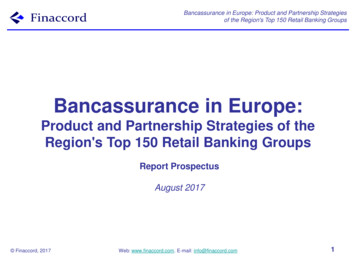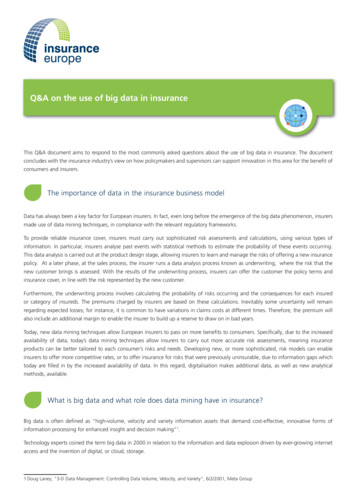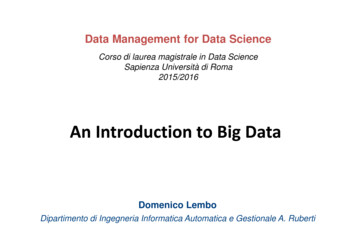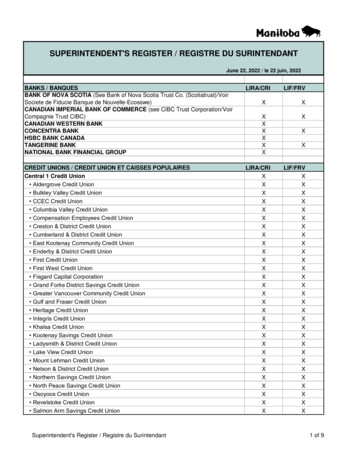
Transcription
Big Data in Life InsuranceDecember 2016
ForewordAs Australia’s newest standalone life insurer, we are looking forward to2017 with optimism and excitement. We are committed to providingaffordable and accessible life insurance products to all Australians.At MLC Life Insurance, we are particularly excited about the opportunity Big Data presents. I’ve been interested in thisfrontier topic for some time, since for me it represents a great unknown. We don’t know what we don’t know when it comes toinformation and how it can be used to the benefit of customers and the industry.To better understand this opportunity and its many challenges we, with the support of the Financial Services Council,commissioned the Big Data in Life Insurance report.This represents a contribution to the Australian life insurance industry. It aims to try and dig a little deeper into how Big Datacan help us to innovate and change the way we do things.The research, conducted by EY Sweeney reveals that we as an industry have lagged behind other major markets when it comesto using Big Data. Other industries are more advanced than life insurers in using large volumes of information to improve howthey interact with customers and provide more innovative products and services.At a time of profound technological change for most industries and their customers we believe in understanding andleveraging the opportunity that Big Data presents.Last year we began our journey into Big Data by investing in MLC on Track, our award-winning health and wellness program,which integrates wearable technology to record health activity and is designed to encourage Australians to lead healthier lives.While it is still early days, more than 17% of all new policy holders have signed up to it and are reaping the rewards of betterhealth and reduced life insurance premiums .Long term, we think the program can reinforce the value of life insurance on a daily basis, rather than just at the point ofclaim or when annual premiums are paid. It will mean life insurance is no longer a “set and forget” financial commitment.Looking ahead, what are the key benefits of Big Data for life insurers and for customers? The report reveals we can expectfaster claims processing, quicker and more accurate underwriting, a streamlining and automation of processes, such asupdating policy and contact details, and also a better prediction of claims in future.While we are by no means the experts in Big Data, we believe that the potential benefits to policyholders and otherstakeholders far outweigh the challenges. So enthused are we, that we have created a Big Data team at MLC Life Insurance.This is a long term focus for us.The future applications of Big Data within our industry are potentially vast. We believe the time is now to set a new course forthe industry. We are delighted to be able to share this report with you.David HackettChief Executive Officer, MLC Life Insurance
Backgroundand ResearchBackground ObjectivesContentsForeward2Background & Research:3Background Objectives3Research Objectives3Specific Research Objectives4Methodology4Interview Coverage4Section 1:What is Big Data?5Section 2:The Opportunity for Big Datain Life Insurance6Customers – The Opportunity6Customers – The Challenge7Industry – The Opportunity7Industry – The Challenges8Section 3: ConclusionThe Future of Big Data withinthe Life Insurance Industry10Section 4: References11About MLC life Insurance,EY and the FinancialServices Council12The Financial Services Council and leaders in the Australian life insurance industrybelieve the sector has been slow to innovate when it comes to the use of Big Data. Whilethere is a keen commercial interest in Big Data across the business world, life insurershave generally been considered to be on the periphery of the discussion.This is the first significant report that captures prevailing attitudes around Big Datain Australian life insurance. It is intended to raise awareness of the opportunity andchallenges, as well as further industry debate around Big Data.The research and insights to support this report were sought from a number of industrysegments, including life insurance providers, general insurers, industry experts andstakeholders from both Australia and abroad.Research Objectives:The key research goal:To gather insights from the life insurance industry (and adjacent industrystakeholders) to foster thinking and debate to build on the use of Big Data in theAustralian life insurance industry. The aim is to stimulate conversation amongstmembers of the Financial Services Council and life insurance providers – to signpostopportunities for better business and customer outcomes, capitalising on the benefitsof Big Data.This report provides insights into the opportunities and challenges faced by theAustralian life insurance industry, but is not intended to be a precise or definitivesurvey of the life insurer population.Big Data for Life Insurance 3
Backgroundand ResearchSpecific Research ObjectivesMethodology1. To establish how insurance companiesare using Big Data around the globe:In order to achieve the research objectives, two research phases were undertaken:–– Key strategies and pathways usedby leaders in this space(Secondary) Data analysis–– How other industries havetransformed, leveraging Big DataAn examination of published relevant local and global materials,research and case studies to inform the discussions with the lifeinsurance industry to inform the qualitative discussions2. To assess and compare Australianinsurers with global leaders:(Primary) In-depth interviews–– How and where is Big Data beingused in Australian life insuranceMostly telephone/Skype in-depth interviews, withsome face-to-face interviews. Each session was45-60 minutes duration.–– Potential roles for Big Data beyondactuarial science–– Industry understanding of Big Data–– Who should ‘own’ Big Data andpotential opportunities3. To assess what may be holding theAustralian industry back:The in-depth interviews were moderated by Courtney Leo and Erik Heller and tookplace between June 14th and July 14th, 2016. The sample breakdown for the interviewswas as follows:In-depth interviews–– If and why Australian lifeinsurance has been held back fromleveraging Big DataIndustry roleAustralian life insurance providers (CEO,CMO, CTO, CIO, etc.)13–– Assess if Australian insurersunderstand what talent, capabilityand infrastructure is needed toleverage Big DataAustralian general insurers (CEO, CMO, CTO, CIO, etc.)2Industry stakeholders (advisers, brokers, resellers, etc.)10–– What key needs there may be –basic education, infrastructureadvice, guidance on advancedanalysisTotal4. To assess how Australian insurersneed to change, to successfullyleverage Big Data opportunities:–– Creative sourcing of data–– Distinct analytics methods–– How to use both to provide acompetitive advantage in lifeinsuranceEY partners/directors (Australian and global)Number of Interviews3 global, 3 local31Interview coverageEach in-depth interview covered the following key areas:1. Industry understanding of Big Data2. Current use of Big Data3. Opportunities for Big Data in life insurance4. Constraints faced by the industry5. Resourcing Big Data opportunities6. Making decisions about Big Data7. The future for Big Data in life insuranceBig Data for Life Insurance 4
Section 1:What is Big Data?“Extremely large data sets that may be analysedto reveal patterns, trends, and associations,especially relating to human behaviour andinteractions.”Life insurance providers, overall, havea sense of excitement at the potentialtransformation of the life insuranceindustry by tapping into Big Data. Theybelieve it will deliver great opportunitiesin the future for both customers and lifeinsurers.Those surveyed believe that it hasthe potential to increase accuracy,efficiency and value by engaging withcustomers in a more meaningful way,and to offer them products and servicesthat are better suited to their needs andcircumstances.For the life insurers, it presents a chanceto re-think and re-work how the lifeinsurance industry is structured andhow it operates. This is an opportunityfor innovation and the evolution ofthe industry from within – improvingprocesses and evolving business models –to ensure a more collaborative interactionwith customers and policy-holders.Headline findings fromthe Big Data in AustralianLife Insurance Report: Opportunity to re-imagine thelife insurance industry, to setcourse for the future Opportunity to re-think theindustry using Big Data to tailorproducts to meet consumer needs Opportunity to use Big Data tominimise traditional areas ofcomplaints for customers Incorporate Big Data to increaseaccuracy and improve riskunderstanding Better deployment of resourcesin the industry, to make themost of Big Data Privacy concerns and theregulatory environment presenta barrier for the industry The challenge of measuring theBig Data opportunity Big Data in the future – willtransform the customer/providerdynamicBig Data for Life Insurance 5
Section 2:The Opportunity forBig Data in Life InsuranceWhile leveraging Big Data represents a big opportunity for a culturaland commercial shift within the industry, most life insurers considerthat the Australian industry lags behind other markets.There is a sense that many in theindustry are “set in their ways” and whilethe opportunity for transformation isreal and present, it may be met withsome resistance by more conservativeelements in the industry.That said, there is a growing feelingamong providers that Big Data can assistin fundamentally changing the lifeinsurer/customer relationship. Manyare excited at the prospect of creatingstronger links and more meaningfulcustomer interactions via Big Data.In the following, we outline theopportunities and the challengesfaced by both the customer and theindustry segments.Customers – The OpportunityThe range of opportunities falls intothree areas: InnovationImproved customer experienceBetter engagement with customersInnovation:When it comes to leveraging Big Data, anew approach to products and serviceswill promote the creation of innovative orrevamped products. Big Data can give usa better understanding of the customerand thus be used to structure productsbased on that better understanding.Further, other markets outside Australiahave already brought new products tothe life insurance sector and we couldlook beyond our borders for inspirationin relation to such things as “dynamicpricing” or “pay-as-you-live” models.Health data can also be used moreeffectively to target specific customersegments and lead to the development ofpersonalised insurance premiums.Improved customer experienceMore and more, and across the world,there is a trend for customers to controltheir own personal data and information,rather than allowing it to be managedby third parties or large institutions.This opens up a big opportunity forcollaboration between life insurers andtheir customers. In collaboration withinsurers, customers can be incentivised tomanage their lifestyle and take on a senseof ownership of their health to adapt theirown policies to their circumstances. Forexample, wearable technology enablesboth the customer and insurer to rewardpositive lifestyle choices or habits –examples of this are already in place inthe general insurance sector via gymdiscounts and the like.Better engagement with customersBig Data is accelerating an evolutionacross financial services and otherindustries, where automation andself-servicing are becoming the normand, increasingly, part of customerexpectations. The internet of thingshas given people more power thanever before to access and to shareinformation.For industry, Big Data can be used toidentify customers, and be able tooffer products and deals. It helps toidentify cohorts and develop a uniqueunderstanding of that cohort and designproducts targeted for them. There isopportunity to use Big Data to pinpointcustomers at certain times in their livesand start conversations in relation tolife changes and how they influenceinsurance purchases – for example thebirth of a child, weddings or even to theother extreme involving the death of aloved one or a natural disaster.It also allows the continuing gatheringof data from customers, rather thanthe current practice of capturing itat one moment in time, either at thetime of underwriting or after a claimis made. As this data is captured ina continual flow, it will bring fasterprocessing opportunities and streamlinethe underwriting process. This willminimise waiting times for receivingand accessing information, which isa continued source of frustration forintermediaries and customers.Big Data for Life Insurance 6
Section 2:The Opportunity forBig Data in Life InsuranceCustomers – The ChallengeIndustry – The OpportunityThe biggest challenge facing the lifeinsurance industry is in relation toinformation sharing and privacyconcerns. This is not industry specific– it is a challenge across all sectors offinancial services, government and otherindustries.Opportunities abound for the lifeinsurance industry, but it is a matter ofshifting the focus from a very traditionalway of doing things, to a more proactiveengagement with customers.Adequate access to data, productrestrictions and regulatory controlsare barriers to be overcome, in order toincorporate Big Data into life insurancemodels. While Data.gov.au makesthousands of data sets available forpublic consumption from a large range ofpublic bodies, there is still a big challengefor providers to access a broader range ofdata from other sources, more generally,to price and redefine products. Productregulations mean premiums and termsof coverage offer fewer opportunities toadapt products to changing customercircumstances.Security of data is a big concern amongcustomers who are uncomfortable withhow much information they reveal, andto whom. Further, they are concernedabout how their information is usedand where it is stored. One possibilitycould be to find ways to link Big Datafrom health insurance or motor vehicleinsurance, to life insurance models,thereby using data that already has beenshared by customers.It is a matter of communicating anddemonstrating the benefits to thecustomer – and life insurers are awarethey need to find ways to impart the ideato customers and intermediaries.The opportunities fall under these maincategories: A new perspective – insurers need toknow more about their customers Partnerships – the key to greaterunderstanding of customers Risk understanding – room forimprovement across the industry Predictions – more effective, inrelation to likelihood of claimsA new perspective will allow insurersto know more about customersBig Data represents an opportunity tore-think how life insurance productsare structured to ensure better valueperceptions and potentially decreasepolicy lapses. If we are able toincorporate information about otherinsurance cover – e.g. motor vehicle,health – that a customer may have,we can gain a 360 degree view of thecustomer and the risk they present.Big Data allows us to measure customerbehaviour and circumstances acrossthe life cycle, rather than at a momentin time. It also helps us understandparticular customer types. Improvedaccuracy about customers will enabledevelopment of more ‘bespoke’ productsand services to meet their needs, andwill mean less reliance on customerself-reporting to help streamline theunderwriting and claims process. Usingmodelling from overseas, we can tapinto trends for product revamps, inrelation to dynamic pricing/pay-as-youlive models etc.Big Data can be used to focus on thefuture and the possibility of claimsor policy lapses on the customer side.On the industry side it can streamlineprocesses in relation to reassessing KeyPerformance Indicators; or identifyingopportunities to automate processes; ordetermining investment priorities.Partnerships – a key to greaterunderstanding of customersThe life insurance industry has a bigopportunity now to mirror the ‘macrophenomenon’ of data sharing usingtechnology (e.g. Google analytics, socialmedia) to generate access to more data.Access to more information is essentialfor the industry to ‘thrive and survive’and opens up opportunities to leverageBig Data to create a more detailed viewof current and potential customers inthe future.Partnership will allow an exchangeof data, to give life insurers moreinformation on which to base individual,tactical and strategic discussions, but itwill only happen if providers, partnersand customers are willing to sharetheir data in a legally compliant way.Partnership can open up other industriesfor information sharing, like medicalresearch, and greater collaboration withother industries or organisations willcreate further links and alignments formutual benefit.The end result means less guess work,as decisions will be based on better anddeeper information.Big Data for Life Insurance 7
Section 2:The Opportunity forBig Data in Life InsuranceRisk understanding – room forimprovement across the industryWith more insights and more data, andwith the right analytics in-house tounderstand risk, insurers believe theycan hone in on the right measures andvariables to better understand risk. Adeeper understanding of risk usingBig Data will help insurers gain a morecomplete picture of their customers,revealing more information about thelikelihood of the need to make a claim.The more information held by insurers,the more accurate the risk assessmentscan be, and this will lead to greateraccuracy in pricing decisions.Predictions – more effective inrelation to likelihood of claimsConsolidation of systems in companiesgives opportunity for analysis of datasets and better use of rich data alreadyin the system.As insurers gather more informationprovided by Big Data, it can be added toexisting data sets, and can streamlinethe claims process at times when therelationship with the policy holder ismost sensitive – that is, around the timeof a claim. Use of Big Data can improvethe claim process in areas including:recoveries; loss adjustment and at-faultdetermination. Further potential forusing Big Data is in claims triage andlifecycle management. A positiveoutcome of using Big Data is in relationto pricing structures, where there canbe a financial benefit for customers whoare shown to be less likely to make aclaim in the future.Industry – The Challenges: Resistance – in spite of the need forindustry transformation The Big Data platform conundrum –management and storage of data The business case for Big DataInsurers see the need forindustry transformation, butthere is resistanceAcross the industry, traditional playersare still unconvinced about the Big DataOpportunity and don’t wish to challengethe status quo, despite the bigger pictureview that, across the world, all industriesare meeting the challenge of technologyand opening up the opportunities.Those who are resistant will need tosee examples of successful leverageof Big Data and also the potential ROIfrom Big Data investment, and theyneed to see proof that technology cantransform data capture and integrationfrom others who have proven the model.Concomitantly, companies are reluctantto invest in Big Data because thebenefits are not clear or proven.The Big Data platformconundrum – managementand storage of dataIt is the challenge faced by all industriesusing Big Data. Whilst it may drive newthinking and create opportunities forlife insurance providers, there is concernabout how data is managed withinorganisations. A decision needs to bemade as to whether to create an in-houseplatform or outsource to a specialist. Itis forcing a re-think about the role oftechnology, from the traditional view oftechnology as a back-office support tool,to a new view of technology as a strategicdifferentiator.There is value in comparing life insurancecompanies with high-tech companies likeAmazon or Apple – why not speculateabout what the customer experiencemight be if these companies used theirplatforms to distribute life insurance?Can our industry create a similarexperience? Providers are neverthelessconfident that they are equipped tomanage Big Data and can move quickly,once the systems are in place.Unfortunately, the market in Australiahas had few internal or external forcesfor change – there is less urgency toincorporate Big Data because of a lack of‘disruptive’ entrants to the market.Big Data for Life Insurance 8
Section 2:The Opportunity forBig Data in Life InsuranceThe business case for Big DataThe market dynamic in Australia could belimiting as it stands, due to tight controlsand regulations. Until now, life insurancehas been sold as part of a super solution orthrough intermediaries, and occasionallydirectly via banking and otherintermediaries meaning customers aremostly removed from the insurer. Manyunderstand the need to transform and usetechnology to innovate, but it is hard toimagine how Big Data can be incorporatedinto current business models.Some feel there are too many unknowns,which can weaken the business case fordecision makers – especially when theROI needs to be quantified. Remembertoo, that the size of the prize in Australiais smaller in a 24 million people marketcompared to most of the rest of the world.This leads to a view there is less urgencyto transform.CFOs, in particular, require more ‘proof’on the ROI than is currently consideredpossible, in relation to the benefits ofBig Data. The life insurance marketis described as a “competitive marketwith low margins” and the cost is stillquite high. Therefore they can put theargument that it is hard to fit Big Datainto a traditional business case model.Big Data for Life Insurance 9
Section 3:Conclusion - The Future of Big Datawithin the Life Insurance IndustryA lack of urgency in relation to Big Data represents athreat to the life insurance industry. Many believe alack of pioneering thinking, and a lack of disruptionis leaving the industry vulnerable because lifeinsurers are not being forced to innovate.However, the general consensus is that BigData will be used far more in the future.From the life insurer’s perspective, there isa sense that the life insurance industrymust use Big Data to survive. There isenough evidence from other sectors thatcustomer intelligence and tailoring isincreasing productivity and profitabilityand the same benefits could be realised forthe life insurance industry.As Big Data is considered an emergingopportunity for some in the industry, itis all too easy to divert resources to other,more pressing matters, which can stallprogress. The key question for theindustry is whether the Big Dataopportunity will be prioritised in thecontext of other needs.It is clear to many of us that Big Data willassist in fundamentally changing theinsurer-customer relationship for thebetter.We must embrace the Big Data in LifeInsurance Report which reveals thatwe have been, until now, slow toinnovate, change and revolutionisethe way we do things.Big Data is at the heart of a dynamic,customer-focused life insurance industryfor the future.It is critically important for dataspecialists and business decision-makersto work together in collaboration toexplore new and creative ways to usetechnology and leverage the Big Dataopportunity.Big Data for Life Insurance 10
Section ournalarticles/ J5MV6.dpufVol: 37 Issue: 2 Apr 2014Jon Tindall - Senior Consultant Finity ConsultingBig Data - Better Life Insurance;Issue: November 2013 LifeLouis Rossouw, Research & AnalyticsActuary, Cape TownBig Data Analytics in Life InsuranceJanuary 6, 2015 Point of ViewBig data: Why it matters for lifeand health insurers6 January 2016 Ronan McCaugheyHow Big Data Is ChangingInsurance ForeverBernard Marr, ContributorMaking Sense of Big Data in InsurancePuneet Bharal, ACORD and Amir Halfon,MarkLogicData Analytics in life insurance: lessonsfrom predictive underwritingWilliam Trump, 26 May 145 Ways Big Data Is Making a Splashin the Insurance IndustryLarisa BedgoodBig data what is it?Issue 6: December 2013/January 2014 –Volume 10 The Actuary MagazineTwo-thirds of life insurers use big dataanalytics [chart]Dec 02, 2014 LIMRAInfographic: How life insurers areusing or plan to use big data andpredictive analytics2015 North American Life InsuranceCFO Survey April 2016Cognizant Enables Guardian LifeInsurance to Modernize Big DataInfrastructure for Improved BusinessInsights and Digital Services. CognizantBIGFrame Solution Facilitates AdvancedAnalytics through AutomatedOptimization and Migration ofMainframe DataMar 08, 2016, 06:00 ET from CognizantLife insurers expect to make significantstrides in their use of big data andpredictive analytics. Carriers concentrateon unlocking big data’s full potentialMay 4, 2016Trends in medical data recordingand their potential impact on insuranceand reinsurance.SCOR October 2015Data collection: Wearable fitness deviceinformation tracking your lifeApril 18, 2015 Kelsey MunroData is wearable? An early look atwearables for life and living benefitsinsurance Munich ReBig Data for Life Insurance 11
About MLC Life Insurance, EY andthe Financial Services CouncilMLC Life InsuranceEY SweeneyFinancial Services CouncilMLC Life Insurance is a specialisedlife insurance business. It represents alandmark strategic partnership betweenNational Australia Bank (NAB) andNippon Life Insurance under which NABretain 20% shareholding and NipponLife hold a majority 80% of the shares inMLC Limited, the entity which operatesthe MLC Life Insurance business. TheAustralian-led and managed businessaims to leverage Nippon Life’s globalpresence, built over 127 years, alongsideMLC Life Insurance’s significantexperience in understanding andmeeting the insurance needs of everydayAustralians since 1886.EY is a global leader in assurance, tax,transaction and advisory services. Theinsights and quality services we deliverhelp build trust and confidence in thecapital markets and in economies theworld over. We develop outstandingleaders who team to deliver on ourpromises to all of our stakeholders. In sodoing, we play a critical role in buildinga better working world for our people, forour clients and for our communities.The Financial Services Council (FSC)has over 100 members representingAustralia’s retail and wholesalefunds management businesses,superannuation funds, life insurers,financial advisory networks and licensedtrustee companies.The industry isresponsible for investing more than 2.7 trillion on behalf of 13.0 millionAustralians. The pool of funds undermanagement is larger than Australia’sGDP and the capitalisation of theAustralian Securities Exchange and is thethird largest pool of managed funds inthe world. The Financial Services Councilpromotes best practice for the financialservices industry by setting mandatoryStandards for its members and providingGuidance Notes to assist in operationalefficiency.For more information on MLC LifeInsurance, visit mlc.com.auEY refers to the global organisation, andmay refer to one or more, of the memberfirms of Ernst & Young Global Limited,each of which is a separate legal entity.Ernst & Young Global Limited, a UKcompany limited by guarantee, doesnot provide services to clients. For moreinformation about our organisation,please visit ey.com.MLCI000037M1116 2016 Ernst & Young, Australia.All Rights Reserved.ED None.eysweeney.com.auMLC Limited uses the MLC brand under licence. MLC Limited is part of the Nippon Life Insurance Groupand not a part of the NAB Group of Companies.Big Data for Life Insurance 12
3. Opportunities for Big Data in life insurance 4. Constraints faced by the industry 5. Resourcing Big Data opportunities 6. Making decisions about Big Data 7. The future for Big Data in life insurance (Secondary) Data analysis An examination of published relevant local and global materials, research and case studies to inform the discussions .










